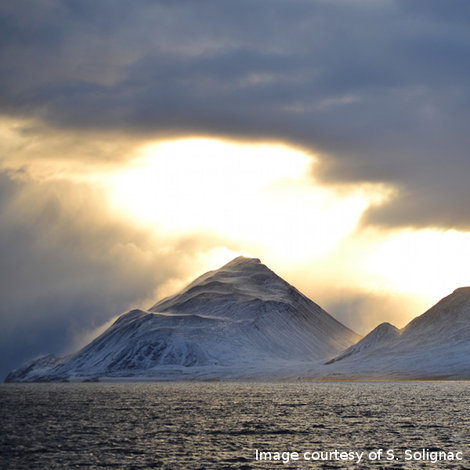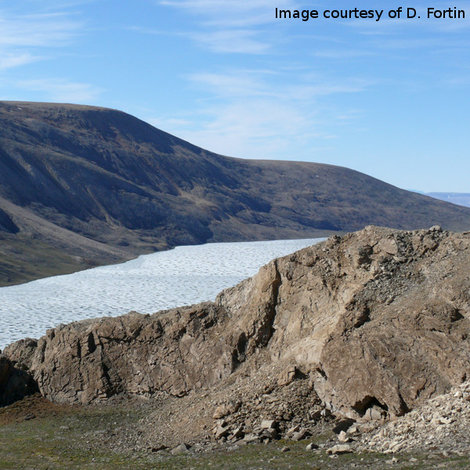Die Inhalte dieser Seite sind leider nicht auf Deutsch verfügbar.
Overarching research questions
Projections of future climate changes suggest that the northern high latitudes will experience an amplified response of the physical environment compared to the global mean (IPCC, 2007; AMAP 2011). At the same time, climate change in the Arctic realm has the potential to trigger cascades of events that can affect the climate system at a global scale. The reason is that ocean circulation, atmospheric circulation and the cryosphere are all coupled in the high latitudes, whilst large-scale ocean circulation and the atmosphere provide the means to transmit climate change signal from the Arctic across the globe. In particular, the Arctic sea-ice cover directly impacts the Earth's heat budget through albedo, whereas the sinking of surface waters into the deep northern North Atlantic Ocean is a key process in linking climate changes between high and low latitudes.

Paleoclimate reconstructions have revealed with great confidence that the pattern of water transformation in the North Atlantic can assume several different states. Of specific importance in this context is the strength of the Atlantic meridional overturning circulation (AMOC). Paleoceanographic data provides strong evidence that the strength of this circulation and the location of convection sites have varied considerably on timescales of centuries to millennia. A principle forcing mechanism is due to perturbations of the hydrological cycle and the freshwater budget of the North Atlantic and Arctic Oceans. Climate warming not only leads to a spin-up of the hydrological cycle (IPCC, 2007) but may also lead to enhanced melting of the Greenland ice sheet. The excess freshwater injected into the surface layer of the deep-water formation areas in the North Atlantic may impede the sinking of surface waters to the ocean interior due to their reduced density.
Despite its importance for the global climate system, projections of the future strength of the AMOC are still associated with considerable uncertainties (IPCC, 2007). Moreover, the future melting of the Greenland ice sheet is insufficiently quantified to assess the potential effect of the resulting pattern and magnitude of meltwater input into the Labrador Sea and the Greenland Sea, which are at present the major sites of deep-water formation in the North Atlantic. Geological reconstructions of past meltwater events and the response of the AMOC provide a means to test its sensitivity to freshwater perturbations. A well-studied example is the so-called “8.2-kyr event”, which was associated with catastrophic drainage of remnant lakes that developed during the retreat of the Laurentide ice sheet 8,200 years ago. For this short lived event, reconstructions and model simulations have shown that high resolution analyses on spatial and temporal scales are required to achieve reasonable agreement between data and model results. As another example, the large meltwater discharge during the last deglaciation had only little effect on the reconstructed AMOC strength despite a shift in the location of convection sites, while many models suggest a strong response. These latter results suggest that the sensitivity of deep-water formation in the North Atlantic to meltwater perturbation may be incompletely represented in state-of-the-art climate models.
Climate change in the Arctic may not follow a change in forcing in a steady fashion. Instead, the system may reach a threshold beyond which a small change in the forcing can result in a disproportionate response. Such tipping points often arise from feedback processes in the climate system. In polar regions, sea ice plays a central role in several strong feedback mechanisms. One example is indeed the ice-albedo feedback which acts to accelerate warming (or cooling) by the reduced (enhanced) reflectivity of a shrinking (rising) sea-ice extent. The record of past changes in sea-ice cover encompasses only the past few decades for which satellite data exist. These data reveal an increasing rate in the loss of sea-ice in the Arctic. However, state-of-the-art models fail to reproduce the observed trend. An important question is whether the downward trend is irreversible or whether sea ice extent may recover in the near future (e.g. under a CO2 stabilization scenario).

One way of assessing the significance of the observed trend is to place it in the perspective of longer-term variability. Novel proxy-indicators are now available and the development of data assimilation techniques should now help reconstructing the history of sea-ice cover during past warm intervals from marine sedimentary archives, and thus test the hypothesis of a relative stability of the Arctic sea-ice cover. Similarly, paleoceanographic data can be used to extend observations from physical oceanography beyond the instrumental period. This approach allows placing the observed variability of ocean circulation in the context of the range of natural variability. Moreover, the extended time series provide valuable information for testing climate models. These examples highlight the need to constrain the uncertainties in process understanding and provide information to improve models used for future projections of climate change in the Arctic. The assessment of impacts of climate change on this region relies on the robustness of the underlying climate models. The apparent accelerated climate change in the Arctic requires advancing our understanding of the underlying processes in order for policy makers to be able to respond on a timescale of societal relevance. Based on the cases mentioned above, major progress can be achieved by linking information on past and present climate changes in a coherent framework reaching across discipline boundaries. The Arctic hot spot of climate change is thus ideally suited to train a new generation of climate scientists in an interdisciplinary research environment. The scientific goal of ArcTrain is to advance the understanding of the interactions between the cryosphere and the ocean in the Arctic realm on time scales of decades to millennia. This knowledge will be used to benchmark current trends and inform climate models to be able to robustly assess the impact of projected future changes on the Arctic oceanic environment. The research agenda of this proposal will combine marine geology, physical oceanography, glaciology, climate modeling, geochemistry and remote sensing in an innovative approach connecting past, present and future climate changes.


